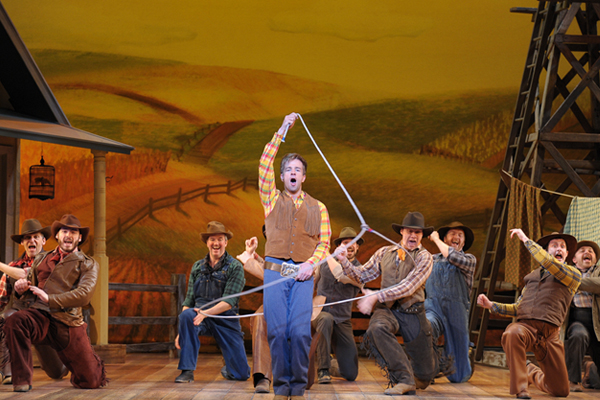
PHOTOGRAPH: DAN REST/LYRIC OPERA OF CHICAGO
When the wind comes sweeping down the plain toward the Lyric Opera of Chicago this week, it will herald more than a new production of Oklahoma!, the classic 1943 musical by Richard Rodgers and Oscar Hammerstein II. Directed by Gary Griffin and starring Broadway veterans John Cudia and Ashley Brown, Oklahoma!, which runs May 4-19, is the first of five musicals the Lyric plans to mount in a springtime production in each of the next five years in a unique collaboration with the Rodgers & Hammerstein Organization, the New York-based organization founded by the legendary composer-lyricist duo. The Lyric will present The Sound of Music in 2014, Carousel in 2015, The King and I in 2016, and South Pacific in 2017.
The Lyric/R&H partnership is the brainchild of Anthony Freud, the Lyric’s general director, and star soprano Renée Fleming, the company’s creative consultant. It’s part of the Lyric’s overall strategy of reaching out to audiences who aren’t regular operagoers but might be tempted by a musical or a hybrid evening such as The Second City Guide to the Opera, a Second City spoof that sold out in January and returns for a second run at the Civic Opera House on May 31-June 30. If they come for a musical, the theory goes, they might come back for an opera.
“The challenges that opera companies face are incredible, from audience development to funding to maintaining relevance in our lives today,” says Fleming, who recently starred as Blanche DuBois in a new semi-staged production of André Previn’s “A Streetcar Named Desire” at the Lyric and New York’s Carnegie Hall. “Opera houses are intimidating to some people, and programs like Second City and the musicals we’re doing let people come into the theater who might not have been there before.” It’s true, too, that the iconic Rodgers & Hammerstein musicals were originally produced on a grand scale—including large casts with separate choruses for singing and dancing, elaborate sets and large orchestras—that most theater companies, and even most Broadway revivals, can’t afford to match today.
“What we’re offering at the Lyric is the opportunity to stage these classic pieces on the level they originally conceived,” says Griffin, who directed Broadway’s The Color Purple in 2005 and, more recently, A Little Night Music and Sunday in the Park with George at Chicago Shakespeare Theater, where he is associate artistic director. “These are classic works of musical theater that have stood the test of time, and they deserve the productions that a great opera company like the Lyric can give them.” The collaboration was made possible in part by the Lyric’s rousing 2012 staging of Jerome Kern’s Show Boat, in which most of the cast of opera singers carefully calibrated their voices and performance style to fit the material while still treating Kern’s soaring score with respect.
“I’m not sure I would have been as receptive if the Met [the Metropolitan Opera Company] had come after us with this,” Chapin says. “The Lyric has always had one of the more enlightened and progressive reputations as an opera company, and they understand the differences and similarities between the American musical and the opera world. In opera, the music tends to be all-important, and in musicals the drama is all-important. But I think that’s led people to misconceive musicals as making the music not that important. At the Lyric, you’re going to get both. There’s going to be fine acting, but you also know the musical aspect is going to be honored.”
In the case of Oklahoma!, Griffin has a pair of Broadway singer-actors in Cudia (leading roles in Les Misérables and The Phantom of the Opera) and Brown (the title role in Mary Poppins and Magnolia Ravenal in the Lyric’s Show Boat) as sweethearts Curley and Laurey, along with David Adam Moore as their brooding nemesis, Jud Fry. Griffin also has a uniquely authoritative choreographer in Gemze de Lappe, 91, who is recreating the dances (including the famous dream ballet) originally set by her mentor, Agnes de Mille.
“Oklahoma! was a groundbreaking show when it was first produced—nobody had seen anything like it—and it’s still very powerful today,” Griffin says. “It opens, famously, with a woman churning butter, and so it’s very all-American and homespun. But it also has a lot of dark moments, a lot of depth, that can be surprising. If you treat it with integrity and respect and passion, it reveals itself to be a more impressive piece of work than most of us know.”


